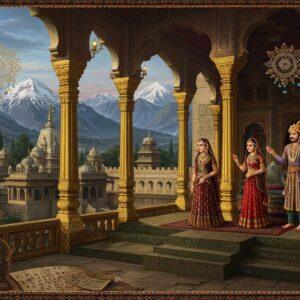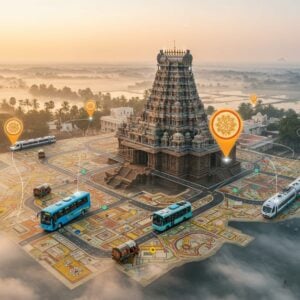
Mysore is not just a city; it’s a feeling, a grand story whispered through its magnificent palaces and vibrant streets. The heart of this story belongs to the Maharajas of Mysore, the illustrious Wadiyar dynasty. For over 500 years, from 1399 to 1950, they didn’t just rule a kingdom; they nurtured a culture, built a legacy, and shaped an identity that continues to shine brightly today. Let’s take a journey back in time to understand the profound impact of these royal patrons.

The Dawn of a Dynasty: How It All Began
The tale of the Wadiyar dynasty started in 1399 with its founder, Yaduraya. In the beginning, they were loyal chieftains under the powerful Vijayanagara Empire. But destiny had bigger plans. As the wheels of time turned and the Vijayanagara Empire began to wane, Timmaraja Wodeyar II made a bold move in 1565, declaring Mysore an independent kingdom. Later, the visionary Raja Wadiyar I expanded its borders and, in 1610, shifted the capital to Srirangapattana, setting the stage for a golden era.
Patrons of Art and Builders of Marvels
The Maharajas of Mysore had a deep love for art and culture, and it showed in everything they did. They were more than just rulers; they were true connoisseurs. Their greatest architectural gift to the world is the breathtaking Mysore Palace, a stunning masterpiece of Indo-Saracenic design that still leaves visitors spellbound. It stands as a grand symbol of their vision and opulence.
But their patronage went far beyond buildings. They breathed life into the cultural landscape of the region. The Wadiyars were instrumental in the development of Carnatic music, and their courts were graced by some of India’s finest musicians and dancers. They supported literature and traditional arts, ensuring that these precious traditions were not just preserved but flourished for generations to come. You can bring a touch of this royal elegance into your own home with beautiful decorative items that echo the grandeur of Mysore’s heritage.
Navigating the Tides of Change: Mysore and the British
The latter half of the 18th century brought turbulent times with the rise of Hyder Ali and Tipu Sultan, during which the Wadiyars’ power was diminished. After the fall of Tipu Sultan, the British restored the kingdom to the Wadiyar family, and Mysore became a princely state within the British Indian Empire. Despite this complex political situation, the Maharajas showed remarkable resilience. They skillfully navigated the new reality, focusing on modernizing the state with significant administrative and economic reforms. They played a supportive role in India’s journey towards independence, always encouraging dialogue and progress.
A “Saintly King”: The Golden Reign of Krishnaraja Wadiyar IV
Among the many great rulers, the name Nalwadi Krishnaraja Wadiyar IV shines with a special light. His reign is often called the ‘golden age of Mysore’. He was a true visionary who believed in progress for his people. He championed education by building schools and colleges, improved healthcare facilities, and invested in infrastructure, including Asia’s first hydroelectric power station at Shivanasamudra. His commitment to social welfare and poverty alleviation was so profound that Mahatma Gandhi himself respectfully called him a “Rajarshi” or “saintly king.”
A Graceful Transition: The Era of Jayachamarajendra Wadiyar
When India gained independence in 1947, it was time for another historic transition. The last ruling Maharaja, Jayachamarajendra Wadiyar, played a pivotal role in gracefully merging the princely state of Mysore with the newly formed Indian republic in 1950. A true statesman, he served as the Rajpramukh and later as the Governor of Mysore. He continued the family’s tradition of cultural patronage, leaving behind a rich legacy in music and literature.
The Living Legacy: How the Maharajas’ Spirit Endures
Today, the legacy of the Wadiyar dynasty is woven into the very fabric of Mysore. It’s visible in the grand celebrations of the Mysore Dasara festival, a tradition they nurtured, which now attracts people from all over the world. Their contributions have made Mysore a major hub for tourism, culture, and education. The spirit of the Maharajas lives on in the city’s reverence for tradition and its forward-looking vision.
Connect with Royal Traditions through Poojn.in
Inspired by the rich heritage of the Mysore Maharajas? At poojn.in, we believe in keeping these sacred traditions alive. Just as the royals patronized art and rituals, you can bring a piece of that devotional elegance into your life.
- Embrace Divine Art: The Maharajas were great devotees. Beautify your sacred space with our exquisite collection of deity photo frames and wall hangings, reflecting the artistic patronage of that era.
- Perform Authentic Rituals: Uphold traditions with the purest ingredients. We provide a complete range of Pooja Samagri to help you perform your ceremonies with the same devotion and authenticity as practiced for centuries.
At poojn.in, we are dedicated to being your trusted partner in your spiritual journey. Explore our vast collection and experience the convenience of having authentic cultural goods delivered right to your doorstep. For any assistance, feel free to call us at 03369029784 or send a message on WhatsApp at 9476142738.


